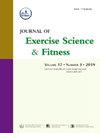Influence of a diaphragmatic fatigue protocol in healthy male population on muscle strength, respiratory function and exercise capacity: A randomized clinical trial
IF 2.4
2区 医学
Q2 SPORT SCIENCES
引用次数: 0
Abstract
Background
Inspiratory muscle fatigue has been shown to impair physical performance. This study investigated the impact of a specific inspiratory muscle fatigue protocol on lower limb muscle strength and cardiorespiratory outcomes in a cohort of physically active individuals.
Method
A randomized controlled trial, adhering to CONSORT guidelines to ensure methodological rigor. Healthy male participants were randomly assigned to an inspiratory muscle fatigue group (EG) or control load group (CG). The EG performed a diaphragmatic fatigue protocol involving inspiratory exercises at 60 % of their maximal inspiratory pressure (MIP), while the CG performed two sets of 30 repetitions at 15 % of MIP. Measurements, including countermovement jump (CMJ), forced expiratory volume in 1 s (FEV1), forced vital capacity (FVC), FEV1/FVC ratio, half squat (HS), peripheral oxygen saturation (SpO2) and MIP, were collected before and immediately after the intervention.
Results
Forty participants completed the study. Significant group-by-time interactions were found for CMJ (p < 0.001; η2p = 0.405), FEV1 (p = 0.030; η2p = 0.118), FEV1/FVC (p < 0.001; η2p = 0.279) and HS (p < 0.001; η2p = 0.332), all with moderate to large effect sizes. Post-hoc analysis revealed a significant decrease in CMJ in the EG (p < 0.001, −8.4 %), while the CG showed no significant change (p = 0.092). FEV1/FVC decreased significantly in the EG (p = 0.007, −5.3 %), while the CG showed a significant increase (p = 0.015, +4.7 %). Similarly, HS decreased significantly in the EG (p = 0.002, −6.3 %), while the CG showed a significant increase (p = 0.007, +5.4 %). No significant interactions were observed for SpO2, heart rate, MIP or FVC.
Conclusions
Diaphragmatic fatigue significantly impairs lower limb strength in physically active individuals, potentially compromising athletic performance and increasing injury risk. These findings enhance understanding of the interplay between respiratory and muscular strength in athletes.
健康男性膈肌疲劳方案对肌肉力量、呼吸功能和运动能力的影响:一项随机临床试验
研究表明,呼吸肌疲劳会损害身体机能。本研究在一组体力活动个体中调查了特定的吸气肌疲劳方案对下肢肌肉力量和心肺结局的影响。方法随机对照试验,遵循CONSORT指南,以确保方法的严谨性。健康男性参与者被随机分配到吸气肌疲劳组(EG)或控制负荷组(CG)。EG组以最大吸气压力(MIP)的60%进行膈肌疲劳练习,而CG组以最大吸气压力的15%进行两组30次重复。在干预前和干预后立即收集反动作跳(CMJ)、1 s用力呼气量(FEV1)、用力肺活量(FVC)、FEV1/FVC比值、半蹲(HS)、外周氧饱和度(SpO2)和MIP等指标。结果40名参与者完成了研究。CMJ (p < 0.001; η2p = 0.405)、FEV1 (p = 0.030; η2p = 0.118)、FEV1/FVC (p < 0.001; η2p = 0.279)和HS (p < 0.001; η2p = 0.332)存在显著的群体-时间交互作用,均具有中大型效应量。事后分析显示EG的CMJ显著降低(p < 0.001, - 8.4%),而CG无显著变化(p = 0.092)。EG组FEV1/FVC显著降低(p = 0.007, - 5.3%),而CG组FEV1/FVC显著升高(p = 0.015, + 4.7%)。同样,HS在EG组显著降低(p = 0.002,−6.3%),而CG组显著升高(p = 0.007, + 5.4%)。SpO2、心率、MIP或FVC未观察到显著的相互作用。结论:在体力活动个体中,膈肌疲劳会显著损害下肢力量,潜在地影响运动表现并增加受伤风险。这些发现加强了对运动员呼吸和肌肉力量之间相互作用的理解。
本文章由计算机程序翻译,如有差异,请以英文原文为准。
求助全文
约1分钟内获得全文
求助全文
来源期刊
CiteScore
5.10
自引率
3.60%
发文量
54
审稿时长
31 days
期刊介绍:
The Journal of Exercise Science and Fitness is the official peer-reviewed journal of The Society of Chinese Scholars on Exercise Physiology and Fitness (SCSEPF), the Physical Fitness Association of Hong Kong, China (HKPFA), and the Hong Kong Association of Sports Medicine and Sports Science (HKASMSS). It is published twice a year, in June and December, by Elsevier.
The Journal accepts original investigations, comprehensive reviews, case studies and short communications on current topics in exercise science, physical fitness and physical education.

 求助内容:
求助内容: 应助结果提醒方式:
应助结果提醒方式:


